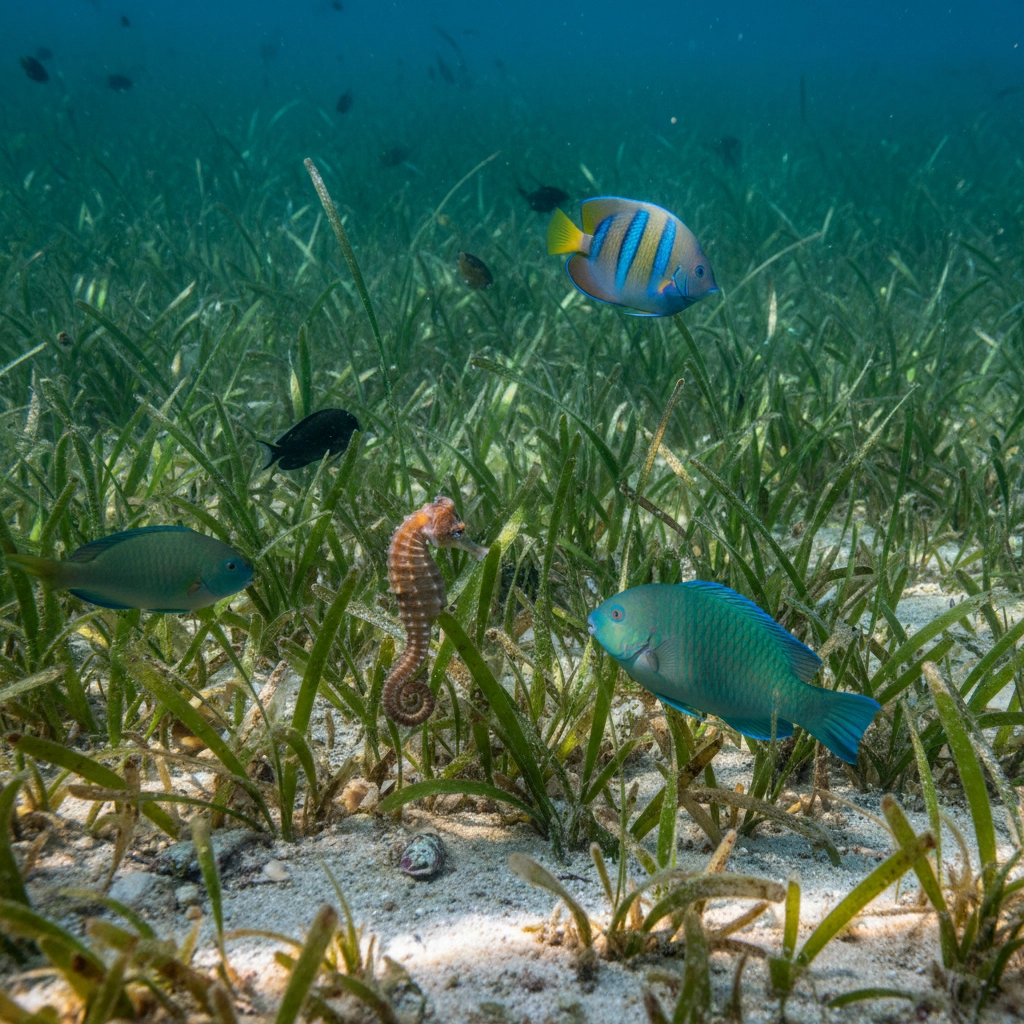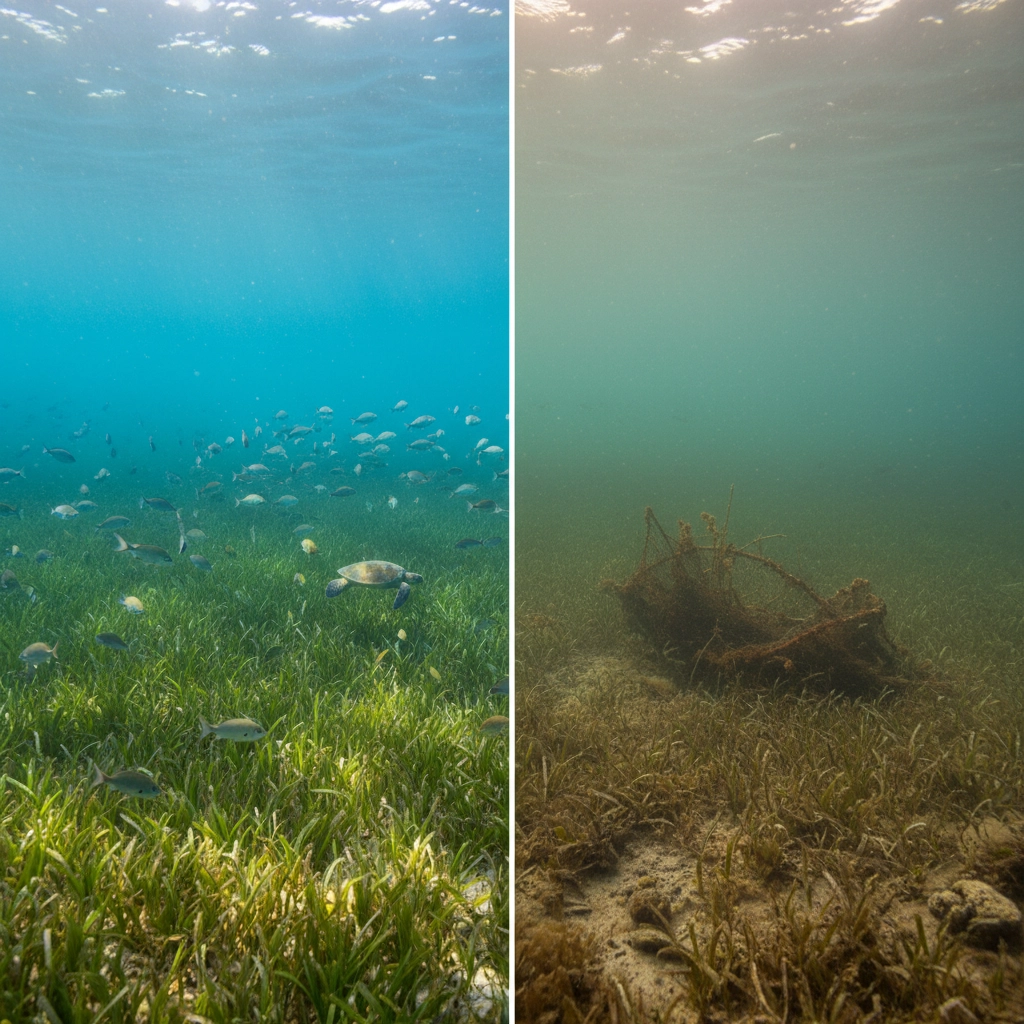Sea Grasses of the Florida Keys: Why They Matter
- Caleb Mullenix
- Oct 23
- 5 min read
Understanding the critical role of seagrass ecosystems represents a fundamental component of comprehensive marine science education. The Florida Keys National Marine Sanctuary encompasses over one million acres of seagrass habitat, forming part of the largest contiguous seagrass meadow on Earth. These underwater flowering plants serve as the foundation for one of the world's most productive marine ecosystems, providing essential educational opportunities for students to examine real-world ecological processes through hands-on learning experiences.
Preparing students for marine science expeditions to the Florida Keys requires establishing clear learning objectives that emphasize the interconnected nature of marine ecosystems. Seagrass meadows offer unparalleled opportunities for students to observe, document, and analyze the complex relationships that sustain marine biodiversity while developing critical thinking skills essential for future scientific endeavors.
Identifying Seagrass Species: A Foundation for Student Research
The Florida Keys harbor several distinct seagrass species, each presenting unique characteristics that students can learn to identify and classify during marine science trips. Turtle grass (Thalassia testudinum) dominates the seagrass beds throughout the region, featuring flat, ribbon-like blades that grow up to 14 inches long with distinctive parallel veins. Students participating in hands-on learning trips can easily recognize this species by its robust structure and observe how green sea turtles graze extensively on these meadows.
Manatee grass (Syringodium filiforme) provides students with opportunities to examine morphological adaptations, as this species features distinctive cylindrical blades resembling thin straws that can reach lengths of up to 20 inches. During earth science educational trips, students discover how manatee grass tolerates deeper waters than turtle grass and often intermixes within turtle grass beds, demonstrating species coexistence and habitat partitioning.

Shoal grass (Halodule wrightii) represents the third primary species students encounter, while smaller populations of star grass (Halophila engelmanni) and paddle grass (Halophila decipiens) offer advanced identification challenges. Students develop observational skills by documenting the star-like whorls of star grass and the paddle-shaped blades with finely serrated edges characteristic of paddle grass.
Ecological Functions: Understanding Ecosystem Services Through Direct Observation
Seagrass meadows perform critical ecological functions that students can observe and measure during marine science expeditions. These underwater plants demonstrate natural water filtration processes by trapping sediments and slowing water flow, allowing students to witness how pollutants from land settle onto the seafloor rather than reaching sensitive coral reefs. Students conducting water quality tests can document the brilliant blue water visible on coral reefs, partially attributed to this filtering action by seagrasses.
Through photosynthesis demonstrations and oxygen measurement activities, students observe how seagrasses produce oxygen, help sequester carbon dioxide, and contribute to minimizing ocean acidification. These direct observations provide concrete examples of ecosystem services that students can quantify and analyze during their marine science trip to Florida Keys.
The stabilization functions of seagrass root systems and rhizomes become apparent to students through erosion studies and seafloor examination activities. Students learn to identify areas where seagrass loss has resulted in coastal erosion, understanding the practical implications of habitat conservation. During storm season discussions, students examine how seagrass beds buffer coastal areas from wave action and storm surges, providing natural protection that directly impacts human communities.
Critical Nursery Habitats: Observing Marine Life Diversity
Students participating in marine science expeditions discover that seagrass meadows serve as critical nursery areas for numerous economically and ecologically important fish and invertebrate species. The dense blade structure provides shelter that students can explore through snorkeling activities, documenting juvenile fish populations and resident species including pipefishes and seahorses.
Hands-on learning trips enable students to conduct species counts and biodiversity assessments within seagrass beds, comparing population densities to adjacent habitats. Students observe feeding behaviors of sea turtles, manatees, and herbivorous fish, documenting the food web relationships that depend on seagrass productivity.

Through underwater observation techniques, students examine how the complex three-dimensional habitat structure created by seagrass blades supports different species at various depths and locations within the meadow. These direct observations reinforce concepts of habitat complexity and species diversity that students can quantify through systematic data collection methods.
Student Research Opportunities: Water Quality and Nutrient Cycling
Marine science expeditions to the Florida Keys provide students with exceptional opportunities to examine seagrass meadows as natural water treatment systems. Students learn to conduct water quality testing procedures, measuring how seagrasses remove excess nutrients from runoff before these nutrients cause ecological problems. Through comparative analysis, students document how seagrass plants absorb dissolved nutrients that would otherwise fuel harmful algae blooms.
Earth science educational trips incorporate nutrient monitoring activities that demonstrate how low nutrient conditions favor turtle grass growth, while elevated nutrient levels promote nutrient-loving algae. Students develop skills in environmental monitoring by learning to recognize early warning signs of water quality deterioration through seagrass health assessments.
Students participating in hands-on learning experiences examine sediment trapping mechanisms, measuring how seagrasses reduce water turbidity and maintain the clear water conditions essential for coral reef health. These practical applications demonstrate the interconnected nature of marine ecosystems while developing students' analytical capabilities.
Economic Connections: Understanding Human-Environment Interactions
Comprehensive marine science education includes examining the economic relationships between healthy ecosystems and human communities. Students learn that healthy seagrass beds contribute more than $20 billion annually to the Florida economy by providing habitat for commercial and recreational fish species. Through fisheries data analysis, students examine how seagrass meadows support the fishing industry, tourism, and recreational activities that form the backbone of the Keys' economy.
Students conduct economic impact assessments by examining how seagrass loss affects water clarity, tourism revenue, and recreational opportunities. These activities demonstrate the practical importance of conservation efforts while reinforcing the connection between scientific understanding and informed decision-making.

Conservation Challenges: Preparing Students for Environmental Stewardship
Marine science expeditions must address the numerous threats facing seagrass populations throughout the Florida Keys. Students examine data on increased sea surface temperatures, reduced freshwater inputs, elevated salinity levels, and excess nutrients that stress these sensitive ecosystems. Through comparative habitat analysis, students observe locations where fleshy macroalgae has replaced seagrass, documenting the loss of important ecological functions.
Hands-on learning trips include vessel grounding impact assessments, as students examine damage from the more than 300 vessel groundings that occur within the sanctuary each year. Students learn that nearly 80% of these groundings impact seagrass habitat, developing understanding of direct human impacts on marine ecosystems.
Students participate in restoration planning activities, examining successful seagrass restoration techniques and contributing to long-term monitoring efforts. These experiences prepare students for future environmental stewardship roles while demonstrating how scientific research directly informs conservation strategies.
Implementing Effective Seagrass Education Programs
Successful marine science trips to Florida Keys require careful preparation that emphasizes safety protocols, clear learning objectives, and structured data collection procedures. Teachers should establish pre-trip activities that introduce seagrass identification techniques, ecological concepts, and research methodologies students will employ during their expedition.
Ensure that students understand the importance of non-invasive observation techniques and proper snorkeling procedures when examining seagrass habitats. Emphasize the significance of accurate data collection and scientific documentation throughout all activities. Provide students with waterproof data sheets, identification guides, and measurement tools essential for comprehensive seagrass studies.
Create opportunities for students to contribute to ongoing research initiatives and citizen science projects that extend their learning beyond the expedition timeframe. Connect classroom learning with real-world conservation challenges by engaging students in habitat monitoring activities and restoration planning discussions.
Marine science expeditions to study seagrass ecosystems in the Florida Keys provide students with unparalleled opportunities to examine complex ecological relationships through direct observation and hands-on research activities. These educational experiences develop critical thinking skills, environmental awareness, and scientific methodology understanding essential for future conservation leaders. Through comprehensive seagrass education programs, students gain practical experience with ecosystem assessment techniques while developing deep appreciation for the interconnected nature of marine environments.



Comments